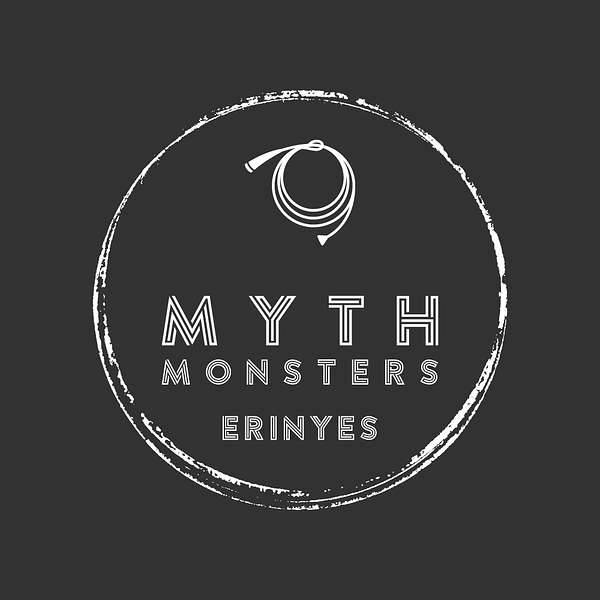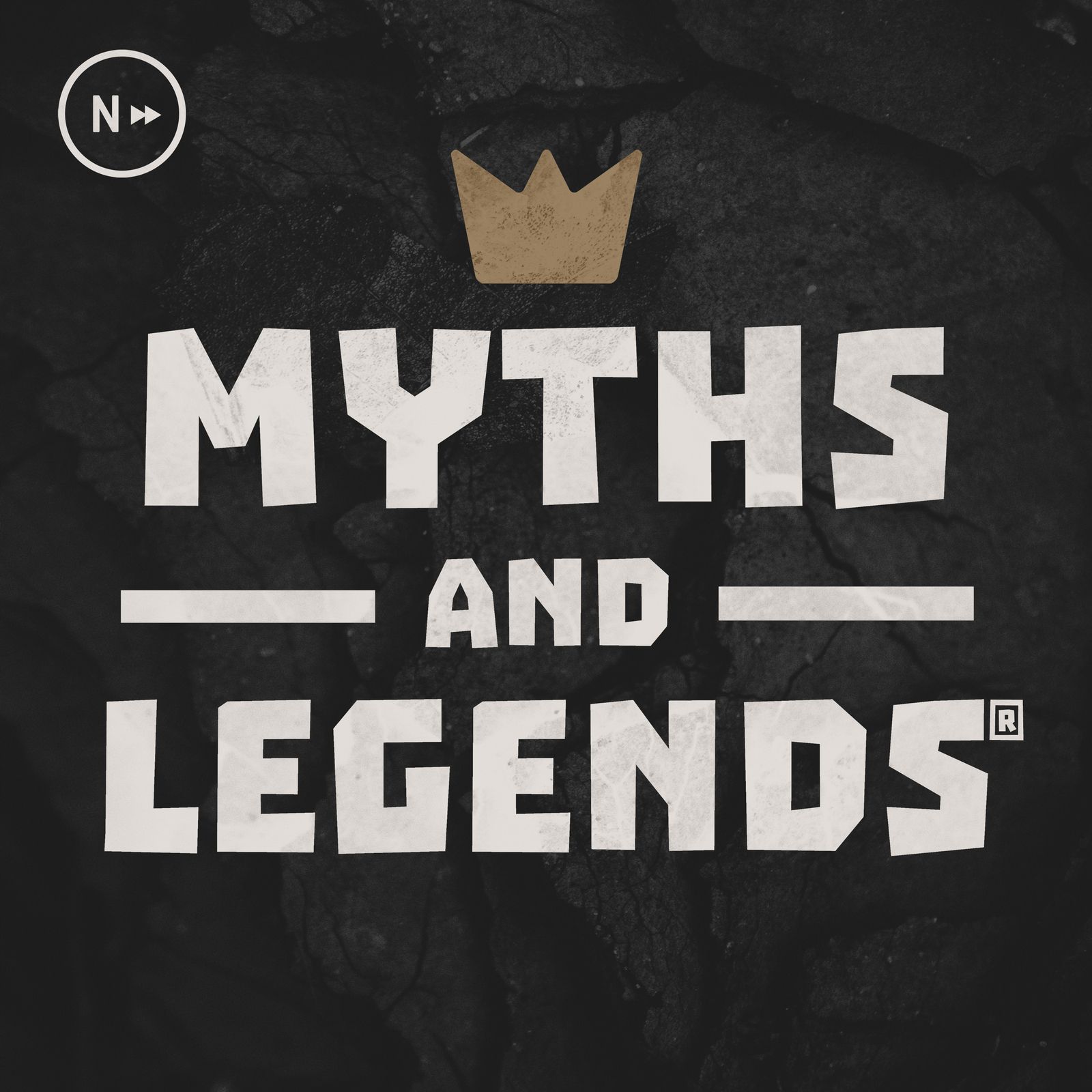
Myth Monsters
A bite sized look into the monsters of global folklore, cryptozoology and mythology with your host, Erin. Jump in and learn about your favourite monsters from Gorgons to Kelpies, to Wendigos to Bigfoot. Stay spooky every Thursday with a new episode with a new monster from another culture. Get in touch on Twitter at @mythmonsterspod
Myth Monsters
Erinyes
For this week's episode, we're heading over to ancient Greece for three monsters, but also goddesses - the Erinyes! How do these monsters deliver vengeance? How did they come to be from blood or darkness? Find out this week!
You can find us on:
Social media:
INTRO:
Hello and welcome to Myth Monsters, my name is Erin and I’ll be your host for these little snack bite size podcasts on folklore and mythical monsters from around the world.
These podcasts focus on the actual cryptids, folklore and mythic monsters from global mythology, rather than focusing on full stories of heroes and their big adventures.
I’ll also be dropping in some references that they have to recent culture and where you can see these represented in modern day content so you can learn more, and get as obsessed as I am about these absolute legends of the mythological world.
Gosh, it’s almost the end of the year - and it’s truly miserable in the UK at the moment. BUT I’m very excited for this episode, because the monsters this week are my mythological namesake and are from my favourite mythology - so I hope you’re ready for this one.
DESCRIPTION:
So what am I talking about? It’s the Erinyes from Greek mythology - they’re also known as the Furies if you don’t know them by their Greek name, and they dwindle between god and monster, making them a pretty good candidate for a Myth Monsters episode.
The Erinyes are three minor Chthonic goddesses within the Greek pantheon - what does Chthonic mean I hear you say? Well it means they are bound to the Underworld and the dark and are some of the oldest deities within Greek myth. The goddesses were named Megaera, Alecto and Tisiphone and they were the goddesses of vengeance.
They are described in a few different ways, but always humanoid - usually pretty horrifically with hair full of writhing snakes, bat-like wings, dark sunken eyes, dripping with blood, and mouths that breathe fire, plague or famine. They are also said to have skin filled with corruption and pallid skin, whilst wearing hooded robes.The Furies are known for carrying funeral torches, but as well as this, their preferred weapons were barbed whips in order to torture their victims.
So what do they actually do as goddesses of vengeance? The three Fury sisters all had their own specialisations, with Megaera being the punisher of jealousy, Alecto the punisher of anger, and Tisiphone the punisher of murderers. However, they were mostly used by the more powerful pantheon of Greek gods to avenge wrongdoings to them, for example, oath breakers, but also familial murder - which is a big no-no in the ancient Greek world.
Their other main task was to torture the worst of the worst that had already passed onto the other side, they often lived in Erebus and Tarturus - the deepest and darkest parts of the Greek Underworld.
Now, a quick summary of the Greek underworld is that you have 5 levels, and you would be organised into one for the good or bad deeds you have done in life when you died. There’s Elysium for the warriors, with the river of forgetting, the Lethe, running through it, Asphodel for the average person - a lush field of poppies, Tarturus for the evil and wicked, a rocky dark place where the fiery lake of Phlegethon ran, and Erebus - the darkness of the underworld, a land of nothingness and empty black void. There’s also the House of Hades, where the god of the dead lives and sentences mortals to their level of the Underworld, but we’re not actually entirely sure where it sits in the Underworld itself.
The Erinyes would live between the darkness of Erebus and the tortured souls of Tarturus when they were not on the surface hunting mortals - they would antagonise shades who committed the worst of crimes with words of hatred, resetting their eternal punishments, driving them mad or just mutilating them with their whips or other weapons. I’ll talk about specific people later on.
On the surface, they were relentless in their pursuit of vengeance, not justice, for crimes such as perjury, mistreatment of elders or parents, xenia, which was the law of hospitality, disrespect of the gods, mistreatment of holy people but most of all, murder in any fashion, and would hunt them down until the end of time - making them some of the scariest monsters to ever exist within mythology. They would try to drag their prey back to the Underworld for a lifetime of torture, and if they couldn’t catch them then and there - they would make sure to at least maim their target or make them mad. You can also swear the Furies to attack someone as a person on the surface so that’s pretty cool too - but if you are found to be incorrect about them, they’ll take you instead.
They would also be able to invoke curses, and prevent people from learning too much about the future, as well as taking away a person’s reason, fertility or power as well as making them blind or mad.
Are they evil then? Not really, whilst there is a certain darkness to the Chthonic gods, they were created to do a job. The Erinyes were formed from the blood spilt from the death of the titan, Uranus, when he was castrated by his son, Kronos. When the blood hit the sea, the Erinyes sprung forth from their mother, the earth titan Gaia alongside the Meliae tree nymphs, and the goddess Aphrodite formed from the seafoam from the genitals being cast into the sea. They were born from pure violence, but sometimes it’s also told that they were born from the dark - by the Chthonic goddess Nyx, goddess of dark, and Erebus themselves, which I know I said is a location, but it’s actually the personification of dark - and one of the oldest beings alive, sprung from Primordial Chaos like his sister, Nyx - yeah that’s a thing. But either way, the sister goddesses were born from either god bloodshed or the embodiment of darkness combined - so you can see why they are perceived as evil.
ORIGIN:
Onto etymology, we’re not entirely sure what Erinyes actually means in ancient Greek - but it’s thought that it comes from the name Eris - who was the goddess of Discord and another one of Nyx’s children, and her name literally means discord, but also the word orinein which means to raise, stir or excite. All three goddesses' names have their own etymology, with Megaera meaning ‘jealous rage’, Alecto meaning ‘endless anger’ and Tisiphone meaning ‘vengeful destruction’. One note here is about Megaera, this is not the same Megaera from the myth of Heracles, they just have a very similar spelling and she is not Heracles’ wife.
We can talk about the English version, which is the Furies - however, that’s not massively interesting. Another Greek name is Eumenides - which means the gracious or kindly ones, which might sound a little weird given their reputation. But this was the name spoken by mortals, as to call them by their real name was to invoke their attention, much like Hades never being referred to as this, but by Pluton or ‘the rich one’.
For their history, they’re from Ancient Greece, and so we know that they are really old. But most Greek myths came from plays and books written by worshippers of these gods, and the Erinyes are no exception. They were first mentioned, at least as we know, in the Iliad which is an epic poem written by Homer in the 8th century BC - which gives us most of our information about most Greek myths and monsters. But they’re mentioned throughout Greek theatre and text, one of the most famous was Aeschylus who wrote about the tragic hero Orestes, which is one of their biggest mentions.
Orestes was the son of King Agammemnon and Queen Clytemnestra of Mycenae, and after his father returns from the Trojan War, his mother kills him - committing the horrid sin of mariticide, because he sacrificed their daughter for good winds to sail to Troy with. The Erinyes come to hunt for Clytemnestra, but Orestes beats them to it, killing his mother and committing matricide, meaning that the Erinyes turn their vengeance towards him. Orestes is told by Apollo, god of prophecy, that to escape this torture, he must go to Athens to be heard by Athena, goddess of wisdom in a trial. The Erinyes pitch their case to Athena, but she decides to acquit Orestes and the Erinyes threaten Athena with torturing the city of Athens and poisoning the ground around it. Athena instead gives them new roles, as protectors of justice rather than vengeance and protectors of Athens itself. She also threatens them that she could just zap them with one of Zeus’ lightning bolts as she knows where he keeps them - the Erinyes are then instated as protectors and are then honoured by the people.
Another Greek hero that they come into contact with is Oedipus, the blind king of Thebes. After his pretty tragic life of killing his father, having children with his mother, poking his eyes out and walking around Europe and the Middle East for years, Oedipus finds a place to die in Colonus - which was sacred to the Erinyes. He is told to leave out of fear of him cursing the grounds, but Oedipus was told in a prophecy that he would die in the Erinyes sacred grounds. He tells his tragic story to the Colonians and in pity, they make him a citizen to rid him of the curse he carries. He dies, watched by the Erinyes, and his children go on to murder themselves, driven by Tisiphone. Tisiphone went on to also get another famous hero, Tydeus to eat the brains of one of his enemies, leading Athena, his patron to leave him to die of injuries.
The goddesses also had a hand in the fall of Troy, with Alecto being told by Zeus to prevent the Trojans from the Latins. She would disguise herself as various women, trying to convince their husbands to fight against the Trojans - including King Turnus who figured her out, and so she cursed him with war-mongering blood. She ended up being frustrated with Zeus’ lack of commitment to starting the war without enough strife, and she told him that she would manage this herself.
Lastly, I said I’d give you some examples of the souls within Tartarus that they would enjoy torturing. One of these was Sisyphus, the king of Corinth, who cheated death twice and so was hated by everyone in the Underworld, including Hades and death itself, Thanatos. His eternal punishment is very well known, and it’s that he has to push a boulder to the top of a mountain, only for just as he gets there, the boulder will fall back down again. The Erinyes love his punishment, and often go to watch his eternal struggle whilst dishing out whippings and insults at him. Another is Prometheus, who doesn’t technically get punished in the Underworld, but on the top of Mount Elbrus. He was a titan who stole fire for mortals, and therefore was punished by having his liver eaten by an eagle every day, only for it to grow back overnight and the cycle to begin again. Again, the Erinyes mostly liked to insult and watch Prometheus in his eternal torture.
There are no real life comparisons I can make to these monsters, as are they really monsters? Or are they just goddesses who look like them, and punish the people who commit these atrocious acts? That is a question for the ages, but of course, it means that we don’t have our usual ‘what could they be section’. They’re goddesses, so it’s tricky and frankly, disrespectful to compare them to anything we have on our mortal plane.
In terms of mythical creatures that are like them though, we can bring in some gods that are similar, such as Eris, the goddess of discord, who had bat-like wings and was also born from the darkness. She was responsible for the entire Trojan war, and revelled in humans killing each other, for revenge or not - she is technically their sister in some tellings if you go down the Erebus and Nyx parentage. Speaking of which, another is Nemesis, the goddess of hubris and avenger of crime - making her the good version of the Erinyes. She is another daughter of Nyx, and is where the word Nemesis comes from in English.
Unrelated to Greek mythology, I can’t help but relate them to the Four Horsemen of the Apocalypse - I feel like they would be the ones riding in to destroy the human race in the end days, with their wings and whips and their breath of destruction. I can imagine these cambion like women on horses in the sky, ready to bring us all to justice, or just avenge our forgetting of their pantheon I suppose.
Lastly, they did have some sanctuaries around that you can still visit today such as in Athens, they had a temple near the Areopagus where murderers were trialled, and acquitted defendants were expected to leave offerings to them. Another is in Colonus - where Oedipus died, and in the centre was a grove that no one was allowed to enter as it was said to be his hidden resting place. But they also had temples in Sicyon, Ceryneia and Erythrae, in Arcadia and Megalopolis as well as a festival called Eumenideia, where there would be flower garlands, nephalia - which is where wine is forbidden, and pregnant animal sacrifices, nasty.
CULTURAL SIGNIFICANCE:
Now onto modern media, there is so little with these ladies so I’ve put in the best I can but realistically, not many tropes suit them either so it is a bit tricky.
For art, have a look at The Remorse of Orestes by William Adolphe Bouguereau from 1862 for a beautiful version of the Erinyes or Orestes pursued by the Furies by Carl Rahl from around 1850 for some fantastic portrait art of them. Otherwise, I’d recommend checking out the art from Hades - the video game for some great modern art of these ladies.
In movies, we have; Percy Jackson and the Lightning Thief, The Gorgon & A Wounded Fawn.
For TV, we have; Once Upon a Time, For the Love of Zeus, Charmed, Xena: Warrior Princess & The Twilight Zone.
In video games, we have ones such as; God of War: Ascension, Hades, Percy Jackson and the Lightning Thief, Gods of Olympus & The 12 Labours of Hercules. Both Hades and God of War are big recommendations for them - as they are major characters within these series. Hades is also a seriously fantastic game - so I always recommend this.
My book recommendation this week is of course, Mythos by Stephen Fry because it’s a fantastic book on Greek myth, but I’d also recommend Greek Myths: Meet the heroes, gods, and monsters of ancient Greece by Jean Menzies because all of her mythology books are excellent.
DO I THINK THEY EXISTED?
Now it’s time for, do I think they existed?
Well this one is interesting because this segment is called do I think they existed - me, Erin, your host. And it’s difficult this week because I very blindly follow Greek religion as a Hellenic pagan, so I do believe the Erinyes exist with no question. I truly do believe that if I did ever commit murder, that Tisiphone would be the bane of my afterlife.
However, looking at it from a diplomatic view - it’s difficult to believe because we just don’t know what happens after death. These goddesses are realistically bound to the underworld, which is something most of us would experience after death, maybe bar Hercules or Orpheus, and so none of us know if there is even an afterlife, or if there are gods or a God to greet us at any pearly gates we believe in.
However, growing up within a Western and mostly Christian influenced country, the idea of Satan and his band of demons torturing you for eternity is very common - and really the Furies are just the Greek religion idea of this, but just for very specific crimes.
So yes, I’m slightly biased - and we’ve never covered a Greek god/monster before - so it is new ground for us, but what an interesting concept. I never usually talk about my religion either so it’s always nice to put something personal in this segment.
But what do you think? Did the Erinyes hunt down family killers? Let me know on Twitter!
OUTRO:
I’m so glad we could cover these, I’ve been waiting for so long to bring them up within the podcast as they are my absolute favourite. Although as always, a tricky one to balance between monster and god - but certainly an argument I love to discuss.
Next week, we’re heading over to Malay folklore to look at a really strange creature. We’re buzzing and hopping along with a grasshopper spirit with the Pelesit next Thursday!
For now, thank you so much for listening, it’s been an absolute pleasure. If you enjoyed this podcast, please give it a rating on the service you’re listening on - I’ve got the twitter for any questions, or suggestions on what monsters to cover next and I’d love to hear from you. The social media handles for Tiktok, Youtube, Threads and Instagram are mythmonsterspodcast, and twitter is mythmonsterspod. But all of our content can be found at mythmonsters.co.uk - you can also find us on Goodpods, Buymeacoffee and Patreon if you want to help me fund the podcast too.
Come join the fun though and share this with your pals, they might love me as much as you do.
But for now, stay spooky and I’ll see you later babes.
Podcasts we love
Check out these other fine podcasts recommended by us, not an algorithm.

FolkLands
Tim Downie, Justin Chubb
Chatsunami
Satsunami
The Howdy Beans Podcast!
Luke The Elder Bean!
My Brother, My Brother And Me
The McElroys
Myths and Legends
Jason Weiser, Carissa Weiser, Nextpod
Lore
Aaron Mahnke
Exploration: Dreamland
Exploration: Dreamland
The Neatcast
Jeremy, Zack, Mike
Effin' Cultured
Bobby, Griff, and The Rik
